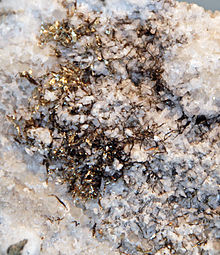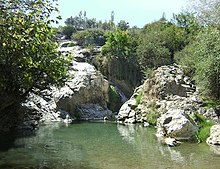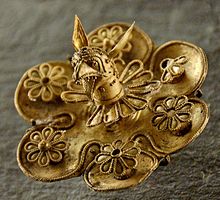
Back إلكتروم Arabic Elektrum Azerbaijani Электрум Byelorussian Електрон (сплав) Bulgarian Electre Catalan Elektrum Czech Elektron (Legierung) German Elektrumo Esperanto Electro (aleación) Spanish Elektron (sulam) Estonian




Electrum is a naturally occurring alloy of gold and silver,[1][2] with trace amounts of copper and other metals. Its color ranges from pale to bright yellow, depending on the proportions of gold and silver. It has been produced artificially and is also known as "green gold".[3]
Electrum was used as early as the third millennium BC in the Old Kingdom of Egypt, sometimes as an exterior coating to the pyramidions atop ancient Egyptian pyramids and obelisks. It was also used in the making of ancient drinking vessels. The first known metal coins made were of electrum, dating back to the end of the 7th century or the beginning of the 6th century BC.
- ^ Chisholm, Hugh, ed. (1911). . Encyclopædia Britannica. Vol. 9 (11th ed.). Cambridge University Press. p. 252.
- ^ "Coinage". worldhistory.org.
- ^ Emsley, John (2003) Nature's building blocks: an A–Z guide to the elements. Oxford University Press. ISBN 0198503407. p. 168